15 years one-stop China custom CNC machining parts factory
 251 |
Published by VMT at Jul 25 2025 | Reading Time:About 8 minutes
251 |
Published by VMT at Jul 25 2025 | Reading Time:About 8 minutes
Choosing the right material is critical in CNC machining—especially when parts must perform under extreme conditions such as corrosion, high stress, or thermal exposure. Many industries—from aerospace to oil & gas—struggle to find a stainless steel that balances strength, machinability, and cost-effectiveness. The wrong choice could mean premature failure, high maintenance costs, or even safety hazards.
This is where 17-4 PH stainless steel stands out. As a precipitation-hardened stainless steel, it offers a rare combination of high strength, excellent corrosion resistance, and favorable machining properties. For manufacturers looking to produce high-performance, durable components using CNC machining services, understanding the value of 17-4 PH stainless steel can save time, reduce costs, and boost product reliability.
In this article, readers will gain an in-depth understanding of 17-4 PH stainless steel, including its characteristics, machining behavior, advantages, and real-world applications—helping engineers and buyers make informed decisions when choosing materials for stainless steel CNC machining parts.
17-4 PH stainless steel is a high-strength, corrosion-resistant alloy widely used in aerospace, medical, and energy applications. Known for its excellent mechanical properties and suitability for CNC machining, it offers a reliable solution for precision parts that require durability, heat resistance, and tight tolerances.
With the overview above, it’s clear that 17-4 PH stainless steel plays a vital role in modern manufacturing. But what exactly sets it apart from other stainless steels? To truly understand whether it’s the right fit for your CNC machining project, let’s take a closer look at its properties, how it compares with similar alloys, and what advantages it brings in real-world applications. Keep reading to explore everything you need to know—from composition and performance to machining techniques and industry-specific benefits.
Key Points Summary
17-4 PH stainless steel is a precipitation-hardened stainless alloy combining high strength, excellent corrosion resistance, and good machinability. It’s widely used in demanding industries like aerospace, marine, and oil & gas.
Thanks to its predictable mechanical behavior and dimensional stability, 17-4 PH stainless steel is ideal for CNC machining parts that require tight tolerances and high-performance material characteristics.
Compared to conventional grades like 304 or 316, 17-4 PH offers superior strength, better fatigue resistance, and customizable hardness through heat treatment—all while maintaining corrosion resistance.
17-4 PH stainless steel responds well to advanced CNC machining services, including milling, turning, Swiss turning, and EDM. It also supports secondary operations like grinding, threading, and laser cutting.
Its versatility makes it suitable for components in aerospace turbines, medical instruments, marine shafts, food processing equipment, and high-pressure valves in the energy sector.
Although slightly more expensive than standard stainless steel, 17-4 PH offers exceptional value due to its long service life, reduced maintenance, and consistent quality.
With key alloying elements like chromium, nickel, and copper, it achieves a high tensile strength (up to 1310 MPa), excellent fatigue resistance, and hardness levels up to HRC 44 when heat-treated.
In short, 17-4 PH stainless steel is a premium-grade solution for stainless steel CNC machining parts where performance, reliability, and strength matter most. It is especially ideal when working with a trusted CNC machining factory that understands the material’s full processing potential.
17-4 stainless steel is a high-performance alloy known for its unique combination of high strength, corrosion resistance, and heat-treatable properties. The “17-4” designation refers to its chemical makeup—approximately 17% chromium and 4% nickel, with added copper and trace elements that enhance its strength and hardenability through a process called precipitation hardening.
This steel belongs to the martensitic family, meaning it can be heat-treated to achieve varying degrees of hardness, making it extremely versatile for applications where strength and durability are crucial. Once aged, it transforms into 17-4 PH stainless steel ("PH" stands for Precipitation Hardening), which exhibits superior mechanical properties.
Unlike austenitic stainless steels such as 304 or 316, 17-4 stainless steel provides significantly higher yield strength and tensile strength—often twice or even three times stronger depending on the heat treatment condition. Despite its toughness, it maintains good corrosion resistance in various environments, including marine and chemical processing.
One of its standout characteristics is the ability to maintain mechanical integrity even at elevated temperatures (up to 600°F or 316°C), which makes it an excellent choice for CNC machined components in high-performance or critical-use industries.
As a result, 17-4 stainless steel is frequently used by CNC machining factories to manufacture precision stainless steel CNC machining parts such as turbine blades, valve components, medical tools, shafts, and structural supports in aerospace and energy systems.
By understanding its fundamental properties, engineers and procurement teams can better assess its fit for demanding CNC machining services and precision manufacturing applications.
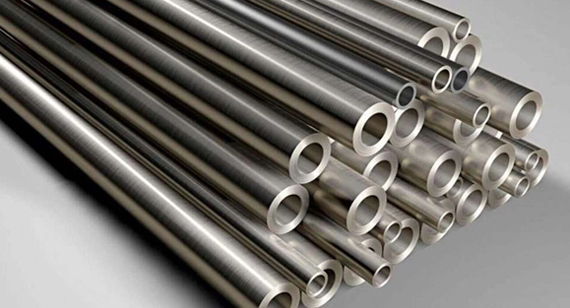
17-4 PH stainless steel is a precipitation-hardened version of 17-4 stainless steel. The “PH” stands for “precipitation hardening,” a heat treatment process that significantly increases the material's strength and hardness without compromising its corrosion resistance. This treatment sets it apart from other stainless steels, giving it the mechanical performance of a hardened alloy with the corrosion protection of stainless steel.
After solution treatment and aging (typically in conditions like H900, H1025, or H1150), 17-4 PH stainless steel achieves exceptional mechanical properties, such as high tensile strength (up to 1310 MPa), good ductility, and a hardness that can reach up to 44 HRC, depending on the heat treatment condition. These properties are retained even at elevated temperatures, making the alloy especially useful in aerospace, petrochemical, marine, and energy industries.
The unique advantage of 17-4 PH stainless steel lies in its balanced combination of machinability, mechanical performance, and corrosion resistance. Compared to conventional grades, it also offers superior dimensional stability during CNC machining and heat treatment, reducing the risk of warping or distortion in complex geometries.
In the context of manufacturing, 17-4 PH stainless steel CNC machining parts are frequently chosen when both durability and tight tolerances are required. Its properties allow for reliable, repeatable results in CNC milling, turning, and other precision processes. Whether you're producing custom tooling, critical fasteners, or load-bearing structural components, this alloy delivers outstanding value and long-term reliability.
With its proven track record and adaptability, 17-4 PH stainless steel is one of the most widely used materials in high-performance CNC machining services today.
At first glance, the terms “17-4 stainless steel” and “17-4 PH stainless steel” may seem interchangeable. However, there is an important technical distinction between the two—especially when it comes to material performance and CNC machining application.
17-4 stainless steel refers to the general alloy before it has undergone any heat treatment. In its raw form, this steel already contains the core alloying elements—approximately 17% chromium and 4% nickel, along with copper and niobium—that provide corrosion resistance and the potential for hardening. However, in this untreated condition, its mechanical properties remain moderate. It is relatively soft and not yet suitable for high-load or high-wear applications.
17-4 PH stainless steel, on the other hand, refers to the material after it has been heat treated through a precipitation hardening process. This process involves solution treatment followed by aging at elevated temperatures (usually between 900°F to 1150°F), which significantly enhances its mechanical strength and hardness. The result is a steel that can be tailored for specific performance requirements depending on the aging condition (H900, H1025, H1150, etc.).
For example:
From a manufacturing standpoint, this distinction is critical. CNC machining factories often choose to machine the material in its annealed state (17-4) and perform aging treatments afterward, ensuring dimensional accuracy and improved material stability. Alternatively, when tolerances must remain unaffected by heat treatment, parts are machined from pre-aged 17-4 PH stainless steel stock.
In short, 17-4 PH stainless steel is the performance-ready version of 17-4 stainless steel. Understanding this difference helps engineers and buyers make smarter decisions when specifying stainless steel CNC machining parts, especially for parts that demand a high level of strength, fatigue resistance, and corrosion performance.
Here's a clear, professional comparison table for "17-4 Stainless Steel vs. 17-4 PH Stainless Steel", designed to help customers quickly understand the key differences:
17-4 Stainless Steel vs. 17-4 PH Stainless Steel
| Feature |
17-4 Stainless Steel (Annealed) |
17-4 PH Stainless Steel (Heat Treated) |
| Definition |
Base alloy before heat treatment | Alloy after precipitation hardening |
| Mechanical Strength |
Moderate strength | High strength (up to 1310 MPa) |
| Hardness |
Relatively soft (good for forming) | Up to 44 HRC (depending on condition) |
| Heat Treatment |
Not yet treated | Treated with aging process (e.g., H900, H1025) |
| Machinability |
Easier to machine in soft state | Machinable, but requires tooling adjustments |
| Corrosion Resistance |
Good | Excellent (slightly improved after aging) |
| Dimensional Stability |
May distort during aging | More stable, with predictable tolerances |
| CNC Machining Use Case |
Preferred for pre-machining before aging | Used for final machining or critical tolerances |
| Applications |
Forming, pre-machining, welding prep | Aerospace, energy, marine, medical components |
This table gives engineers and buyers a quick side-by-side comparison to support decision-making for 17-4 PH stainless steel CNC machining parts.
When it comes to high-performance materials for CNC machining services, 17-4 PH stainless steel consistently stands out for its robust feature set. Its unique ability to deliver both mechanical strength and corrosion resistance—while remaining machinable—makes it a top choice across industries such as aerospace, oil & gas, medical, and marine. However, like any engineered material, it also has limitations that buyers and engineers should be aware of before finalizing a project. Understanding both the strengths and weaknesses of 17-4 PH allows for smarter material selection when sourcing stainless steel CNC machining parts from a trusted CNC machining factory.
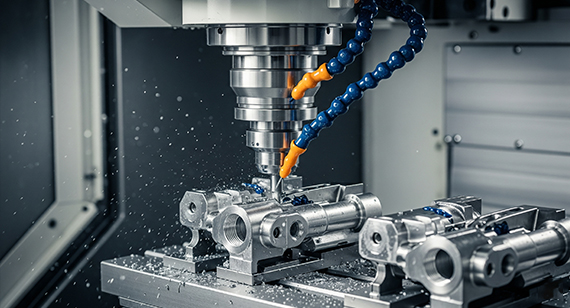
Advantages of 17-4 Stainless Steel
The advantages of 17-4 PH stainless steel stem from its balanced alloy composition and precipitation-hardening process, which make it highly versatile and cost-effective in demanding environments.
Customizable
One of the biggest advantages of 17-4 PH stainless steel is its ability to be customized through heat treatment. It can be aged to various conditions such as H900, H1025, or H1150, allowing engineers to tailor the material's strength, toughness, and hardness to the specific requirements of a part. This adaptability makes it ideal for producing 17-4 PH stainless steel CNC machining parts that must meet tight functional and dimensional tolerances.
High Strength
17-4 PH stainless steel offers exceptional tensile and yield strength, often exceeding 1000 MPa. This level of mechanical performance surpasses that of common stainless steels like 304 and 316, making it suitable for high-stress applications such as aircraft components, gas turbines, and structural assemblies.
Excellent Formability and Weldability
Despite its high strength, the material maintains good formability in its annealed state, allowing it to be bent, formed, or shaped before aging. In addition, it is weldable using standard techniques, which is not always the case with other high-strength steels. This makes it easier to fabricate complex geometries or assembled structures without compromising integrity.
Corrosion Resistance
Thanks to its chromium content (approximately 15–17%), 17-4 PH stainless steel delivers strong resistance to corrosion, even in aggressive environments such as saltwater, chemical processing plants, and humid conditions. It holds up better than many martensitic steels and approaches the corrosion resistance of some austenitic grades.
Thermal and High Temperature Performance
The alloy retains its strength and mechanical stability at elevated temperatures up to 600°F (315°C). This makes it highly suitable for applications like steam turbines, aerospace engine parts, and high-pressure valves where heat resistance is critical.
Superior Resistance
In addition to corrosion, 17-4 PH stainless steel is resistant to fatigue, wear, and stress corrosion cracking, especially in chloride-rich environments. These features are vital for industries that demand long-lasting, maintenance-free parts.
Can Be Designed for Radioactive Storage
Due to its strength and corrosion resistance, 17-4 PH stainless steel has been used in nuclear and radioactive waste containment. It offers stable long-term performance with minimal degradation, which is important in safety-critical storage environments.
Other Advantages
Disadvantages of 17-4 Stainless Steel
While 17-4 PH stainless steel has many strengths, it is not without trade-offs. One limitation is its limited toughness at sub-zero temperatures. Unlike some austenitic grades, 17-4 PH becomes brittle in cryogenic environments, which restricts its use in extremely cold applications.
Secondly, although it offers good corrosion resistance, it may not match the corrosion resistance of 316 stainless steel in highly acidic or chloride-saturated environments. In such cases, alternative stainless steels may be more suitable.
From a machining standpoint, once the material is aged or hardened, it becomes more difficult to machine compared to its annealed form. This requires the use of high-performance tooling, proper coolant application, and experience in precision CNC machining services to maintain tolerances and surface finish.
Additionally, the cost of 17-4 PH stainless steel is typically higher than that of standard stainless grades. While the price is justified by performance, budget-sensitive projects may need to assess the trade-off between strength and cost.
Here's a clear, professional comparison table summarizing the advantages and disadvantages of 17-4 PH stainless steel, designed to help readers evaluate it at a glance:
Advantages and Disadvantages of 17-4 PH Stainless Steel
| Category |
Details |
| Advantages |
|
| Customizable Properties |
Can be heat treated to different conditions (H900–H1150) to achieve specific strength or hardness requirements. |
| High Strength |
Offers excellent tensile and yield strength (up to 1310 MPa), suitable for high-load applications. |
| Good Formability and Weldability |
Easily formed in annealed state; weldable using standard methods. |
| Corrosion Resistance |
Strong resistance in various environments, including marine, chemical, and industrial exposure. |
| High Temperature Performance |
Maintains mechanical strength at temperatures up to 600°F (315°C). |
| Fatigue & Stress Resistance |
Excellent resistance to wear, fatigue, and stress corrosion cracking. |
| Dimensional Stability |
Minimal distortion during heat treatment or CNC machining, ensuring tight tolerances. |
| Applications in Nuclear Use |
Suitable for radioactive storage due to long-term stability and corrosion resistance. |
| Availability |
Offered in many forms such as rods, round bars, and custom forgings for various CNC machining needs. |
| Long-Term Cost Efficiency |
Higher upfront cost is offset by extended part life and reduced maintenance. |
This table is ideal for helping engineers and buyers weigh the trade-offs of using 17-4 PH stainless steel CNC machining parts in various industries.
Disadvantages of 17-4 PH Stainless Steel
| Disadvantage |
Description |
| Limited Cryogenic Toughness |
17-4 PH stainless steel becomes brittle at extremely low temperatures, making it unsuitable for cryogenic applications or components exposed to freezing environments. |
| Reduced Corrosion Resistance vs. 316 |
While corrosion-resistant, it does not match the superior corrosion resistance of 316 stainless steel, especially in chloride-rich or highly acidic conditions. |
| Hard to Machine in Aged State |
Once precipitation-hardened, the material becomes significantly harder, requiring high-performance tools, slower cutting speeds, and careful programming during CNC machining. |
| Welding Challenges After Aging |
Welding aged 17-4 PH steel can reduce its mechanical properties. It typically requires post-weld heat treatment to restore strength and toughness. |
| Not Suitable for Cold Forming |
Cold forming is limited due to its high hardness after aging, which may cause cracking or deformation unless processed in the annealed state. |
|
Higher Material and Processing Cost |
More expensive than general-purpose stainless steels (like 304 or 410), both in raw material cost and machining time, especially if heat treatment is required. |
| May Require Specialized Heat Treatment Facilities |
Not all workshops are equipped for the precise heat aging required for 17-4 PH stainless steel, potentially increasing lead times or outsourcing requirements. |
| Magnetic in Hardened State |
Unlike austenitic stainless steels, 17-4 PH becomes magnetic after hardening, which may be undesirable in applications requiring non-magnetic materials. |
This table helps customers and engineers identify potential risks when choosing 17-4 PH stainless steel CNC machining parts, so they can make informed decisions based on application needs and budget constraints.
17-4 PH stainless steel is widely regarded as one of the most mechanically versatile stainless alloys available for CNC machining services. Its defining characteristic is the ability to achieve high strength and hardness through heat treatment, while still offering excellent resistance to corrosion and oxidation. These properties, combined with good dimensional stability and fatigue resistance, make it a top choice for industries that demand precision-engineered stainless steel CNC machining parts.
Whether used in aerospace actuators, turbine components, surgical instruments, or marine shafts, the consistent and reliable performance of 17-4 PH stainless steel in harsh environments has made it a preferred material for CNC machining factories globally.
Let’s explore the mechanical properties that make this alloy such a high-performing choice.
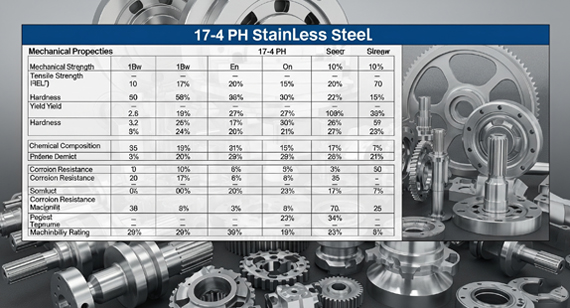
17-4 PH Stainless Steel: Mechanical Properties
The mechanical properties of 17-4 PH stainless steel are what truly set it apart from other stainless steel grades. Through precipitation hardening, its strength, hardness, and fatigue resistance can be customized based on the aging condition selected (such as H900, H1025, or H1150). These values make it highly suitable for CNC machining applications where performance under stress, heat, or load is critical.
The following are the key mechanical properties of 17-4 PH stainless steel under commonly used heat treatment conditions:
Mechanical Property Table – 17-4 PH Stainless Steel (Typical Values by Condition)
| Property |
Typical Range / Value |
Notes |
| Hardness (HRC) |
Up to 44 HRC (H900), 28–35 HRC (H1150) | Varies based on heat treatment; higher values mean greater wear resistance |
| Hardness (HV) |
~400 HV (H900) | Vickers hardness for precise surface evaluation |
| Hardness (HRB) |
~95 HRB (annealed condition) | Useful during forming or pre-machining |
| Tensile Strength (MPa) |
930–1310 MPa | Among the highest for precipitation-hardening stainless steels |
| Yield Strength (Rp0.2, MPa) |
860–1170 MPa | Indicates its ability to withstand applied stress without permanent deformation |
| Ductility (%) |
10–20% | Good formability and resilience in dynamic loads |
| Ultimate Tensile Strength (MPa) |
~1170 MPa (H1025) | Peak stress before fracture |
| Elongation at Break (%) |
10–15% | Allows flexibility under tensile loads before failure |
| Reduction of Area (Z/%) |
45–60% | Indicates material ductility and resistance to cracking |
| Heating Temperature (Aging) |
480°C–620°C | Typical precipitation hardening range depending on condition (H900–H1150) |
| Elastic (Young’s) Modulus (GPa) |
~200 GPa | Indicates stiffness of the material under elastic deformation |
| Fatigue Strength (MPa) |
480–600 MPa | Essential for cyclic loading applications |
| Shear Strength (MPa) |
~730 MPa | Relevant in gears, shafts, and mechanical linkages |
| Shear Modulus (GPa) |
~77 GPa | Useful for torsion and rotational load analysis |
| Modulus of Elasticity |
~200 GPa | Consistent across all heat treatment states |
| Poisson’s Ratio |
~0.29 | Describes the material's deformation in perpendicular directions |
| Reduction of Area |
45–60% | Repeated for emphasis due to its significance in failure prevention |
These mechanical specifications show why 17-4 PH stainless steel CNC machining parts are trusted in mission-critical applications. Its high strength-to-weight ratio and machinability in both annealed and aged states make it ideal for complex, high-precision components.
17-4 PH Stainless Steel: Physical Properties
In addition to its excellent mechanical performance, 17-4 PH stainless steel offers a set of physical properties that make it highly reliable for use in precision CNC machining services. Its combination of high density, stable thermal performance, and resistance to both corrosion and wear allows it to maintain structural integrity across a wide range of operating conditions. These physical characteristics are critical when designing stainless steel CNC machining parts that must perform in extreme or variable environments.
Engineers working with this material benefit from its predictable behavior under heat, pressure, and magnetic fields—making it a dependable choice for aerospace components, turbine parts, surgical tools, and industrial valves.
Below is a comprehensive overview of the physical properties that define 17-4 PH stainless steel and help determine its suitability in advanced CNC machining applications.
Physical Properties of 17-4 PH Stainless Steel
| Property |
Value / Description |
Relevance |
| Condition |
Annealed or precipitation-hardened (H900, H1025, H1150) | Properties vary with heat treatment; defines strength, machinability, and thermal behavior |
| Density |
~7.75 g/cm³ | Typical for high-strength stainless steel; affects weight, inertia, and thermal mass |
| Melting Point (°C) |
1400–1440°C | Suitable for high-temperature applications and welding environments |
| Thermal Conductivity |
~18 W/m·K | Lower than carbon steels; affects heat dissipation during machining and operation |
| Resistivity (Ω·m) |
~0.8 × 10⁻⁶ Ω·m | Important for electrical applications and heat generation under load |
| Thermal Expansion (Linear Coefficient) |
~10.8 × 10⁻⁶ /K | Ensures dimensional stability under temperature changes; critical for tight-tolerance parts |
| Corrosion Resistance |
Excellent in most industrial and marine environments | Resists oxidation, pitting, and stress corrosion cracking in harsh conditions |
| Magnetic Properties |
Magnetic in all conditions | Unlike austenitic steels (e.g. 304), 17-4 PH becomes ferromagnetic, especially after aging |
| Formability |
Good in annealed state; limited after hardening | Suitable for forming operations before precipitation treatment |
| Machinability (Annealed) |
Good | Machining is easiest in the annealed condition; becomes more difficult after aging |
These physical properties highlight the practicality and performance of 17-4 PH stainless steel in high-demand CNC applications. Its ability to withstand mechanical loads while maintaining thermal and chemical stability is why it’s a trusted material across mission-critical sectors.
17-4 PH Stainless Steel: Chemical Composition
The outstanding mechanical and corrosion-resistant performance of 17-4 PH stainless steel is directly tied to its carefully engineered chemical composition. This alloy is classified as a precipitation-hardened martensitic stainless steel, meaning its strength and hardness are not solely a result of cold working but rather depend on the chemical interaction of its key elements during the aging heat treatment process.
Each element in 17-4 PH stainless steel plays a critical role in enhancing the material’s hardness, toughness, corrosion resistance, and machinability. For engineers and buyers sourcing stainless steel CNC machining parts, understanding this elemental breakdown is essential—especially when evaluating material certifications or designing for regulated industries like aerospace, energy, and medical.
Below is a detailed breakdown of the typical chemical composition of 17-4 PH stainless steel:
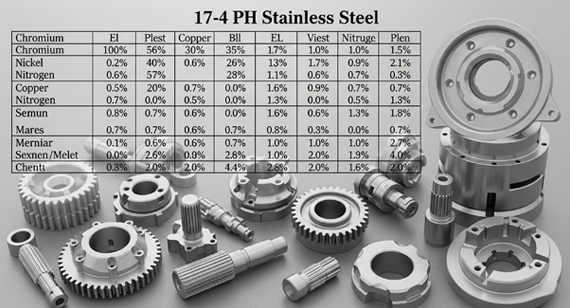
Typical Chemical Composition of 17-4 PH Stainless Steel
| Element |
Content (% by weight) |
Function / Impact |
| Carbon (C) |
≤ 0.07% | Increases hardness and strength; kept low to preserve corrosion resistance |
| Silicon (Si) |
≤ 1.00% | Improves oxidation resistance and deoxidation during steel production |
| Manganese (Mn) |
≤ 1.00% | Enhances strength and hardness; improves hot working properties |
| Phosphorus (P) |
≤ 0.040% | Residual element; excessive amounts can reduce ductility |
| Sulfur (S) |
≤ 0.030% | Also a residual; improves machinability but can slightly reduce corrosion resistance |
| Chromium (Cr) |
15.0–17.5% | Primary corrosion-resistant element; forms a passive oxide layer on the surface |
|
Molybdenum (Mo) |
Not typically present | Rare in standard 17-4 PH; sometimes added for specialized corrosion applications |
| Nickel (Ni) |
3.0–5.0% | Stabilizes the austenitic phase; key to precipitation hardening and toughness |
| Copper (Cu) |
3.0–5.0% | Enables precipitation hardening when combined with aging treatment |
| Iron (Fe) |
Balance (~70%) | Base element providing structural integrity |
| Niobium + Tantalum (Nb + Ta) |
0.15–0.45% | Stabilizers for improved high-temperature strength and weldability |
| Niobium (Nb) |
Part of combined Nb + Ta | Forms carbides to enhance creep strength and stability |
| Thallium (Tl) |
Not present in standard 17-4 PH | Typically not part of commercial formulations; may appear in trace amounts only as impurity |
Notes for CNC Machining Services
Understanding the composition of this alloy helps CNC machining factories select the right cutting tools, speeds, and heat treatment methods to deliver precision components with consistent performance.
When selecting materials for CNC machining services, understanding the key characteristics of the material is critical to achieving both performance and cost-efficiency. 17-4 PH stainless steel is a premium-grade alloy that combines exceptional strength, corrosion resistance, and processing flexibility. These core characteristics are the reason it is frequently specified for high-precision, high-load components across aerospace, medical, marine, and industrial sectors.
In this section, we’ll explore four defining characteristics of 17-4 PH stainless steel—density, hardness, machinability, and heat treatment behavior—to give engineers, buyers, and product designers a clearer picture of its advantages in manufacturing stainless steel CNC machining parts.
17-4 PH Stainless Steel Density
The density of 17-4 PH stainless steel is approximately 7.75 g/cm³, which is consistent with other high-performance stainless steels. This moderately high density contributes to the material’s excellent mechanical stability and impact resistance, making it suitable for structural parts that must withstand dynamic loads or vibration.
In CNC machining applications, knowing the material density helps in accurate part weight calculations, cost estimations, and performance modeling. It also aids in balancing rotating components such as shafts, gears, and turbine parts. When weight control is critical—such as in aerospace components—engineers can factor this density into the overall design without sacrificing strength or reliability.
17-4 PH Stainless Steel Hardness
One of the standout properties of 17-4 PH stainless steel is its hardness, which is highly tunable through heat treatment. In the most common aged condition—H900—it can reach up to 44 HRC, while softer conditions like H1150 typically deliver hardness in the 28–35 HRC range.
This wide range of hardness values makes it an ideal candidate for both wear-resistant and load-bearing applications. The high surface hardness also provides excellent performance in parts that experience repeated friction, such as bushings, pins, shafts, and valve components.
For stainless steel CNC machining parts, the ability to tailor hardness post-machining through precipitation hardening allows for flexible part development, especially when high surface wear resistance is needed without compromising core ductility.
17-4 PH Stainless Steel Machinability
In its annealed condition, 17-4 PH stainless steel offers good machinability, comparable to 304 or 410 stainless steel. This makes it relatively easy to work with using standard CNC milling, turning, and drilling operations. Machinability becomes more challenging after aging (particularly in H900), due to increased hardness and reduced ductility.
To optimize results, CNC machining factories typically:
This strategy allows manufacturers to deliver high-precision components with tight tolerances, excellent surface finish, and extended tool life.
For customers ordering 17-4 PH stainless steel CNC machining parts, it’s important to communicate the final heat-treated condition required, so that both material selection and machining parameters can be optimized accordingly.
17-4 PH Stainless Steel Heat Treatment
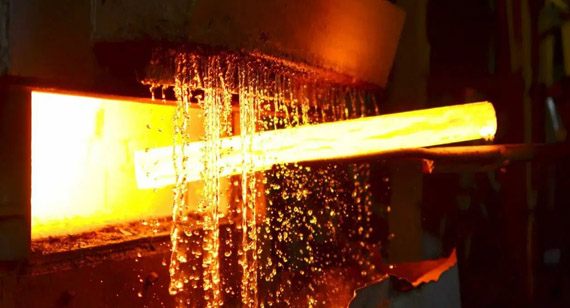
Heat treatment is the cornerstone of 17-4 PH’s performance. Unlike many stainless steels, this alloy undergoes a precipitation hardening process, which involves:
The most common heat-treated conditions include:
This process is not only predictable but also reversible, allowing post-machining aging to fine-tune final part performance. For CNC machining factories, this means greater flexibility in part design, reduced machining stress, and high repeatability—making 17-4 PH a material of choice for mission-critical applications.
Here's a clear, concise, and professional table summarizing the key characteristics of 17-4 PH stainless steel, ideal for helping customers, engineers, and procurement teams quickly assess its suitability for CNC machining applications:
17-4 PH Stainless Steel Characteristics Summary Table
| Property |
Details |
| Density |
~7.75 g/cm³ |
| Hardness (HRC) |
Up to 44 HRC (H900); softer in H1025/H1150 conditions |
| Machinability (Annealed) |
Good; comparable to 304/410 stainless steel; harder after aging |
| Best Machining Condition |
Solution annealed (pre-aging); post-machining aging recommended |
| Heat Treatment Type |
Precipitation hardening (solution + aging treatments) |
| Common Aging Conditions |
H900 (highest strength), H1025 (balanced), H1150 (high ductility/corrosion) |
| Corrosion Resistance |
Excellent; comparable to austenitic stainless steels in many environments |
| Magnetic Properties |
Magnetic in all conditions (unlike 300-series austenitic grades) |
| Weldability/Formability |
Good weldability and formability in solution-treated state |
| Applications |
Aerospace, medical, oil & gas, food processing, marine hardware |
| Ideal for CNC Machining? |
Yes, especially when strength, wear resistance, and corrosion resistance are needed |
The manufacturing process of 17-4 PH stainless steel CNC machining parts is critical to achieving the high-performance characteristics this alloy offers. Due to its excellent mechanical strength, corrosion resistance, and dimensional stability, 17-4 PH stainless steel is widely used in precision components across aerospace, medical, defense, and energy sectors. However, to fully unlock its potential, the right machining processes must be selected based on the alloy’s heat treatment condition, geometry of the part, and functional requirements.
At VMT, a professional CNC machining factory, a full suite of advanced equipment and skilled engineering ensures that every 17-4 PH stainless steel component is manufactured to precise tolerances and superior surface finishes. The following subsections outline the most commonly used CNC machining services for this alloy.
CNC machining is the backbone of precision manufacturing for 17-4 PH stainless steel parts. It encompasses subtractive manufacturing operations that use high-precision computer-guided tools to cut and shape material. This process ensures repeatability, high dimensional accuracy (±0.01mm), and tight tolerance control, especially important for aerospace, medical, and defense applications.
Due to the material’s hardness—particularly after aging (H900 or H1025)—tool wear and heat generation must be carefully managed. Cutting tools with high wear resistance, proper cooling, and optimized speeds are essential.
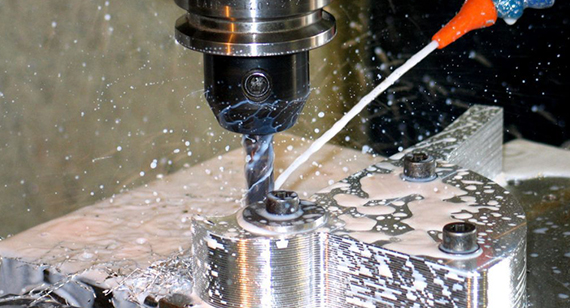
CNC milling is ideal for creating flat surfaces, pockets, slots, and complex 3D contours in 17-4 PH stainless steel parts. Vertical and horizontal milling machines with multi-axis capabilities can produce intricate geometries and undercuts efficiently.
17-4 PH in the solution-annealed state is easier to mill, while the aged condition (H900) may require coated carbide tools, lower feed rates, and efficient chip evacuation to maintain surface integrity and tool life.
CNC turning is commonly used for cylindrical 17-4 PH stainless steel components such as shafts, bushings, and threaded fittings. This process involves rotating the workpiece while a single-point cutting tool removes material. It’s highly efficient for symmetrical parts and provides excellent surface finishes.
For high-hardness conditions, tool materials like ceramic or CBN inserts are recommended, along with proper tool geometry and coolant flow.
Swiss turning is particularly suitable for small, high-precision 17-4 PH stainless steel parts like surgical components, valves, and aerospace fittings. This method uses a sliding headstock and guide bushing, which offers better support during machining, allowing for tight tolerances on long, slender components.
Swiss turning is efficient for high-volume production and minimizes secondary operations due to its ability to perform multiple machining steps in one setup.
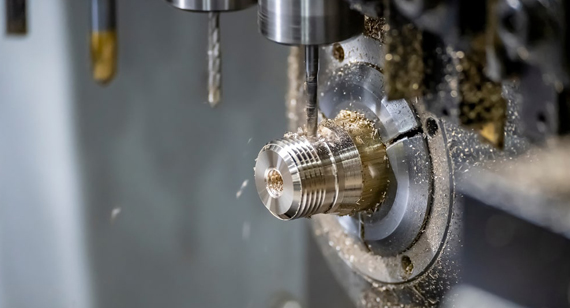
CNC drilling creates precision holes in 17-4 PH stainless steel parts with consistent diameter and depth. Due to the alloy’s strength, especially after aging, drill bits must be coated and highly rigid to avoid deflection or premature wear.
Pilot holes, peck drilling strategies, and coolant-through drills help maintain accuracy and prevent overheating or work hardening.
Electrical Discharge Machining (EDM)
EDM is used when extremely hard or complex shapes are required in hardened 17-4 PH stainless steel. It involves eroding material with electrical discharges (sparks) and is ideal for tight-tolerance internal geometries, sharp corners, and small cavities that traditional cutting tools cannot access.
EDM doesn't introduce mechanical stress, making it suitable for heat-treated or thin-walled parts.
Laser cutting is a non-contact method that uses a focused laser beam to cut 17-4 PH stainless steel sheets and profiles. It offers high speed, excellent edge quality, and minimal distortion, especially beneficial for prototype fabrication and thin parts.
However, edge hardening and slight heat-affected zones must be considered during post-processing.
Wire Cutting (Wire EDM)
Wire EDM is a type of EDM that uses a thin wire as the electrode. It is ideal for cutting intricate profiles and tight internal radii in thick sections of 17-4 PH stainless steel. Wire EDM provides excellent dimensional accuracy (up to ±0.005 mm) and is often used for mold inserts, dies, and high-precision aerospace parts.
Grinding is typically the final step to achieve ultra-fine finishes or exact dimensions. Surface grinders, cylindrical grinders, or centerless grinders are used depending on the part geometry. Grinding is especially useful for hardened 17-4 PH components where extremely tight tolerances and smooth finishes (Ra ≤ 0.2 µm) are critical.
Stamping forming is limited to the annealed condition of 17-4 PH stainless steel. After precipitation hardening, the material becomes too brittle for forming processes. When used, it allows cost-effective shaping of flat components, enclosures, or brackets before heat treatment and final machining.
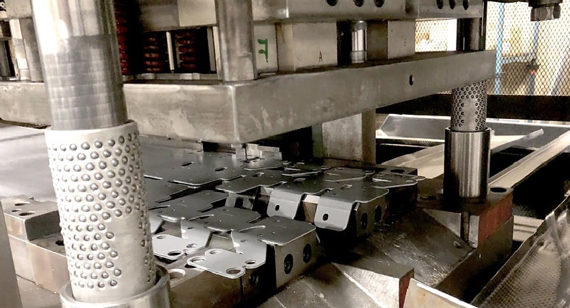
Here's a professional, easy-to-read summary table of the manufacturing processes used for 17-4 PH stainless steel CNC machining, highlighting each method’s purpose and advantages:
Manufacturing Processes for 17-4 PH Stainless Steel
| Process |
Purpose |
Advantages for 17-4 PH Stainless Steel |
| CNC Machining |
General precision shaping and dimension control | High accuracy, tight tolerances, adaptable to complex designs |
| CNC Milling |
Creating flat surfaces, pockets, slots, 3D geometries | Suitable for complex parts; high repeatability |
| CNC Turning |
Producing cylindrical parts like shafts, bushings, and threads |
Efficient for round parts; smooth surface finish |
| Swiss Turning |
Micro parts and long slender components | Ultra-precision; ideal for medical, aerospace, and electronics |
| CNC Drilling |
Creating high-accuracy holes | Precise depth and diameter; good for hard materials after heat treatment |
| EDM (Electrical Discharge Machining) |
Shaping hard materials or internal corners | No cutting force; ideal for tight tolerances in heat-treated conditions |
| Wire Cutting (Wire EDM) |
Cutting complex profiles and internal shapes | Excellent accuracy (±0.005 mm); minimal mechanical stress |
| Laser Cutting |
Cutting thin sheets and custom profiles | Fast, clean cuts with minimal heat distortion |
| Grinding |
Achieving fine finishes and exact dimensions | Smooth surfaces (Ra ≤ 0.2 µm); tight tolerances on hardened parts |
| Stamping Forming |
Shaping flat components before aging | Cost-effective forming when used before heat treatment |
17-4 PH stainless steel is a high-performance material known for its unique blend of strength, corrosion resistance, and heat treatability. These qualities make it one of the most versatile materials for precision CNC machining, especially when dimensional stability and mechanical strength are critical. Industries that operate in harsh, corrosive, or high-load environments often turn to 17-4 PH stainless steel CNC machining parts for reliable, long-term solutions. Below is a breakdown of key sectors where this material is widely used.
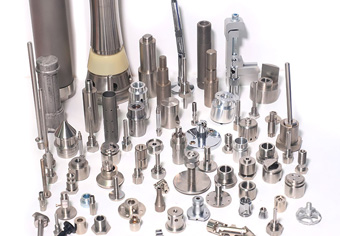
Oil and Gas
In the oil and gas sector, equipment must withstand extreme pressure, corrosive substances, and high temperatures. 17-4 PH stainless steel is used to manufacture critical components such as downhole tools, valve parts, flanges, and pump shafts. Its excellent mechanical performance and resistance to chloride-induced corrosion make it ideal for offshore drilling platforms and deep-sea equipment.
Petrochemical
Petrochemical applications involve exposure to aggressive chemicals and thermal cycling. Here, 17-4 PH stainless steel CNC machined parts are found in reactor vessels, nozzles, and pipe fittings. Thanks to its ability to maintain strength after heat treatment, it ensures long service life and minimal maintenance downtime.
Aerospace
In aerospace, material strength-to-weight ratio and thermal fatigue resistance are critical. 17-4 PH stainless steel is widely used in turbine blades, structural brackets, and fasteners. Its precipitation-hardening ability makes it suitable for high-load, high-stress applications in both military and commercial aviation.
Marine
Corrosion from saltwater is a major challenge in marine engineering. The high corrosion resistance and magnetic properties of 17-4 PH stainless steel make it suitable for components like propeller shafts, marine fasteners, and underwater sensor housings. These parts remain functional and rust-free in harsh marine environments.
Food Machining
The food industry demands hygiene, corrosion resistance, and ease of cleaning. 17-4 PH stainless steel meets FDA requirements and is commonly used in food processing blades, mixers, conveyor systems, and fittings. It ensures compliance with sanitation standards without sacrificing mechanical performance.
Paper & Pulp
Chemical and mechanical wear in the paper and pulp industry makes material choice crucial. 17-4 PH stainless steel is resistant to chemical attack and abrasion, making it suitable for scrapers, rollers, and bearing housings. Its hardness and machinability also reduce replacement cycles and maintenance costs.
Other Applications and Part Uses
Below is a clear and organized table summarizing the applications and common part uses of 17-4 PH stainless steel across different industries:
| Industry |
Typical 17-4 PH Stainless Steel CNC Machined Parts |
Key Benefits |
| Oil & Gas |
Valve parts, pump shafts, downhole tools, flanges | High strength under pressure, corrosion resistance, excellent performance |
| Petrochemical |
Reactor vessels, pipe fittings, nozzles | Chemical resistance, stability in thermal cycling environments |
| Aerospace |
Turbine blades, fasteners, brackets, structural supports | High strength-to-weight ratio, heat treatability, fatigue resistance |
| Marine |
Propeller shafts, fasteners, underwater housings | Saltwater corrosion resistance, magnetic properties |
| Food Processing |
Mixer blades, conveyor systems, valves, fittings | Hygienic, corrosion-resistant, FDA compliant |
| Paper & Pulp |
Scrapers, rollers, bearing housings | Abrasion resistance, chemical resistance, long service life |
| Medical |
Surgical instruments, orthopedic implants | Biocompatibility, precision CNC machining capability |
| Nuclear |
Storage containers, shielding parts | Radiation resistance, high mechanical strength |
| Automotive (Racing) |
Drivetrain components, suspension parts, high-performance brackets | Fatigue strength, impact resistance, weight-saving potential |
| Tooling/Molding |
Injection molds, high-precision dies | Dimensional stability after heat treatment, machinability |
This table helps customers quickly understand where 17-4 PH stainless steel CNC machining parts can be used and why it’s such a valuable material across industries.
When considering materials for high-performance parts, cost is always a major factor. For industries requiring strength, corrosion resistance, and excellent machinability, 17-4 PH stainless steel is a premium choice—but it comes at a cost that reflects its performance. To help engineers, procurement teams, and product developers make informed decisions, it’s essential to understand what influences the price of 17-4 PH stainless steel CNC machining parts and how that compares to other materials.
The price of 17-4 PH stainless steel ranges from $10 to $25 per kg, depending on condition, size, and supply. CNC machined parts made from 17-4 PH typically cost more due to material hardness and precision requirements. Costs are influenced by raw material pricing, heat treatment, complexity, and finish level.
While 17-4 PH is more expensive than general-purpose stainless steel like 304 or 316, its performance advantages in demanding environments often justify the investment. But what exactly drives the cost? Let’s explore key cost factors, average pricing, and how CNC machining impacts the overall expense of using 17-4 PH stainless steel.
Cost Factors for 17-4 PH Stainless Steel CNC Machining Parts
| Cost Component |
Description |
| Raw Material Price |
Typically ranges from $10–$25/kg depending on global supply and size |
| Condition |
Solution-treated or heat-treated bars may cost more due to processing steps |
| Machining Complexity |
Parts requiring tight tolerances, 5-axis machining, or multi-process setups |
| Tool Wear |
High hardness means faster tool wear, increasing tooling cost per unit |
| Heat Treatment Costs |
Parts often require aging or precipitation hardening post-machining |
| Volume & Batch Size |
Lower volumes tend to raise per-part cost; bulk orders benefit from economies |
| Finishing Requirements |
Polishing, passivation, or coating adds to final processing costs |
| Shipping & Lead Time |
Custom sizes or urgent jobs may affect delivery and price per kg or part |
Typical Price Range for CNC Machined Parts
| Part Type |
Estimated Price Range (USD/unit) |
| Small fasteners or bushings |
$5 – $15 |
| Medium-sized brackets |
$20 – $50 |
| Precision shafts or valves |
$40 – $200+ |
| Aerospace or oilfield parts |
$100 – $500+ |
| Prototypes & custom parts |
$30 – $300+ depending on complexity |
Value Consideration
Though 17-4 PH stainless steel carries a higher upfront cost than other stainless steels, it offers cost-efficiency over time through reduced wear, less maintenance, and fewer failures. This makes it especially valuable in critical sectors like aerospace, oil and gas, medical, and marine applications.
Here's a clear, concise breakdown of the national standards and equivalent grades for 17-4 PH stainless steel:
| Standard Organization / Region |
Standard / Grade Name |
Notes |
| UNS (USA) |
UNS S17400 | Universal designation for 17-4 PH stainless steel |
| AISI / SAE (USA) |
630 / 17-4 PH | Common U.S. designation |
| ASTM (USA) |
ASTM A564, A693, A705 | Covers forgings, plate/sheet, and bars |
| EN (Europe) |
X5CrNiCuNb16-4 / 1.4542 | European equivalent under EN 10088-1 |
| DIN (Germany) |
X5CrNiCuNb16-4 / 1.4542 | Same as EN; used for German standards |
| JIS (Japan) |
SUS 630 | Japanese Industrial Standard equivalent |
| GB (China) |
0Cr17Ni4Cu4Nb / GB/T 20878 | Chinese standard equivalent for 17-4 PH |
| ISO |
ISO 15156-3 (NACE MR0175) | Recognized for use in sour gas environments |
| AFNOR (France) |
Z6CNU17-04 | French designation |
| BS (UK) |
BS EN 10088-1 | British Standard (uses EN 1.4542) |
| GOST (Russia) |
12Kh17N4Yu | Closest Russian equivalent |
Here is a breakdown of the different stock shapes of 17-4 PH stainless steel, commonly available for CNC machining and industrial applications:
| Shape Type |
Description / Application |
| Rods | General-purpose cylindrical bars used for machining structural and load-bearing components. |
| T-Rods |
T-shaped cross-sections, often used for structural reinforcement and mechanical assembly. |
| Flat Bars |
Rectangular cross-section; ideal for brackets, plates, and flanges. |
| Round Bars |
Most common form; widely used in shafts, pins, fasteners, and turned components. |
| Hexagonal Bars |
Six-sided bars used for machining hex bolts, fittings, and decorative elements. |
| Square Bars |
Square cross-section bars used in custom-machined parts and supports. |
| Triangular Bars |
Less common; used for specific tooling, artistic, or niche structural purposes. |
| Hollow Bars |
Tubular shape; reduces weight while maintaining strength, used in hydraulic and fluid systems. |
| Threaded Bars |
Pre-threaded rods used for fastening and anchoring applications. |
| Pump Shafts |
Precision shafts used in fluid pumps; leverage 17-4 PH’s corrosion resistance and strength. |
| Ship Shafts |
Marine-grade shafts used in ship propeller systems due to toughness and seawater resistance. |
Here's a structured comparison of 17-4 PH stainless steel vs. other common stainless steels, focusing on mechanical properties, corrosion resistance, machinability, and applications:
17-4 PH Stainless Steel vs. 15-5 Stainless Steel
| Property |
17-4 PH |
15-5 Stainless Steel |
| Composition |
Higher chromium, niobium-stabilized | Similar but more refined (lower delta ferrite) |
| Strength |
Very high tensile and yield strength | Slightly higher toughness and ductility |
| Hardness |
Excellent after aging treatment | Comparable, but better impact resistance |
| Corrosion Resistance |
Very good, especially in salt environments | Very good, with slightly better pitting resistance |
| Machinability |
Good in annealed condition | Better than 17-4 in most conditions |
| Weldability |
Good with proper post-weld heat treatment | Better weldability |
| Applications |
Aerospace, pumps, nuclear | Aerospace, pressure vessels, medical devices |
17-4 PH Stainless Steel vs. 304 Stainless Steel
| Property |
17-4 PH |
304 Stainless Steel |
| Strength |
Much higher (1100–1310 MPa) | Lower (520–750 MPa) |
| Hardness |
Hardenable up to HRC 44 | Non-hardenable |
| Corrosion Resistance |
Good | Excellent general-purpose corrosion resistance |
| Machinability |
Better than 304 due to precipitation hardening | Lower, tends to gum up tools |
| Weldability |
Fair with post-weld heat treatment | Excellent |
| Applications |
Structural aerospace, nuclear, turbine parts | Food, kitchenware, chemical containers |
17-4 PH Stainless Steel vs. 416 Stainless Steel
| Property |
17-4 PH |
416 Stainless Steel |
| Strength |
Significantly higher | Lower, but decent for ferritic stainless |
| Hardness |
Up to HRC 44 after aging | Up to HRC 35 |
| Corrosion Resistance |
Better, especially in chloride environments | Poorer due to high sulfur content |
| Machinability |
Good, but not free-machining | Excellent — one of the best machinable steels |
| Weldability |
Requires care and heat treatment | Poor due to sulfur content |
| Applications |
High-stress parts, aerospace, marine | Screws, nuts, bushings, valves |
Summary: How Does 17-4 PH Stainless Steel Compare to Other Metals?
Here's a concise, well-structured overview of alternatives to 17-4 PH stainless steel, including options based on key performance factors like strength, corrosion resistance, machinability, and cost.
| Alternative Alloy |
Key Features |
When to Use Instead of 17-4 PH |
| 15-5 PH Stainless Steel |
Similar precipitation hardening properties, better toughness and weldability | For aerospace or structural parts requiring better weldability and toughness |
| 13-8 Mo Stainless Steel |
High strength and excellent fracture toughness | When fracture resistance and superior toughness are critical |
| 316 Stainless Steel |
Excellent corrosion resistance, especially in marine and chloride environments | For improved corrosion resistance where extreme strength is not necessary |
| 304 Stainless Steel |
Good corrosion resistance, cost-effective, widely available | For general use where strength and hardness of 17-4 PH are not essential |
| 440C Stainless Steel |
High hardness and wear resistance, but lower corrosion resistance | For wear-critical components where corrosion resistance is less important |
| A286 Alloy |
High-temperature performance with oxidation resistance | For aerospace or turbine applications needing heat resistance |
| Inconel 718 |
Superior strength and corrosion resistance at high temperatures | For extreme environments beyond stainless steel capabilities (e.g., jet engines) |
| Titanium Grade 5 (Ti-6Al-4V) |
Exceptional strength-to-weight ratio, excellent corrosion resistance | For aerospace, medical, and weight-sensitive components |
Summary:
Choose an alternative based on application needs:
Yes, 17-4 PH stainless steel can be used for knives, but it's not commonly preferred for high-performance cutting tools. Here's a breakdown of its suitability:
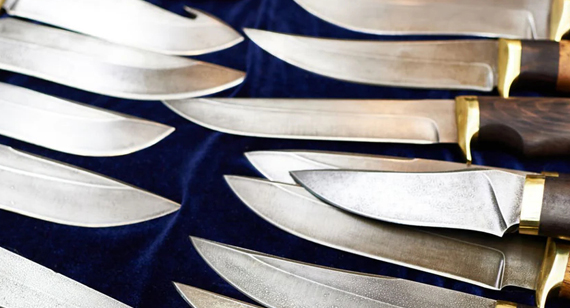
Advantages:
After heat treatment, 17-4 PH can reach up to HRC 44–47, providing good edge durability.
Its chromium content (15–17.5%) offers good rust resistance, suitable for humid or mildly corrosive environments.
Ideal for precision parts; it maintains shape well after machining and heat treatment.
Disadvantages:
Compared to knife steels like S30V, VG-10, or 440C, 17-4 PH has lower wear resistance and won’t hold a razor edge as long.
The high hardness may make sharpening slower, especially with basic sharpening tools.
It’s an engineering-grade steel optimized for structural and aerospace components, not fine cutting tools.
Verdict:
Here’s a quick breakdown to help you decide if 17-4 PH stainless steel fits your CNC machining or product requirements:
Choose 17-4 PH Stainless Steel if you need:
Ideal for aerospace, marine, medical, and high-performance mechanical components.
Easier to CNC machine than many hardened steels.
Minimal distortion during heat treatment—perfect for tight tolerance parts.
Achieves high strength without expensive alloying elements like in Inconel or titanium.
Avoid 17-4 PH if you need:
For high-chloride or acidic environments, super duplex stainless steel or 316L may be better.
It’s strong, but not designed for deep subzero or high-heat fluctuation use.
Not suitable for high-end blades or surgical instruments where razor-sharp edges are needed.
Bottom Line:
17-4 PH stainless steel is a versatile, reliable, and widely available choice for CNC-machined parts that require a balance of strength, hardness, and corrosion resistance. If your project demands mechanical performance and stable tolerances, it's likely a strong match.
VMT is a leading precision CNC machining service provider specializing in stainless steel CNC machining parts for diverse industries, including aerospace, medical, automotive, electronics, and industrial equipment.
Why Choose VMT?
Skilled in machining a wide range of stainless steels including 304, 316, 17-4 PH, 440C, 303, 410, and 1.4116.
High-precision 3-axis, 4-axis, and 5-axis CNC machines for complex geometries and tight tolerances.
Tailored machining services for prototypes and high-volume production—milling, turning, drilling, tapping, and more.
ISO 9001-certified facility with CMM inspection, full material traceability, and ROHS-compliant finishing.
Includes passivation, polishing, bead blasting, electropolishing, black oxide, and more.
Fast, reliable worldwide delivery with professional packaging and logistics.
Key Stainless Steel CNC Machining Capabilities:
| Material |
Features |
Typical Applications |
| 304 |
Good corrosion resistance, easy to machine | Brackets, enclosures, fittings |
| 316 |
Superior corrosion resistance | Marine, medical, food processing parts |
| 17-4 PH |
High strength & hardness, good corrosion resistance | Aerospace parts, structural components |
| 440C |
High hardness, wear resistance | Knife blades, valve parts |
| 1.4116 |
Wear resistance + corrosion resistance | Surgical tools, knives |
Contact VMT Today
Get a quote or DFM consultation for your stainless steel CNC machining parts.
Website:https://www.machining-custom.com/
Email: inquiry@vimetal.com.cn
Location: Building 14, DaweiShahe Industrial Zone B2, Xinzhuang Community, Matian, Guangming, Shenzhen, China
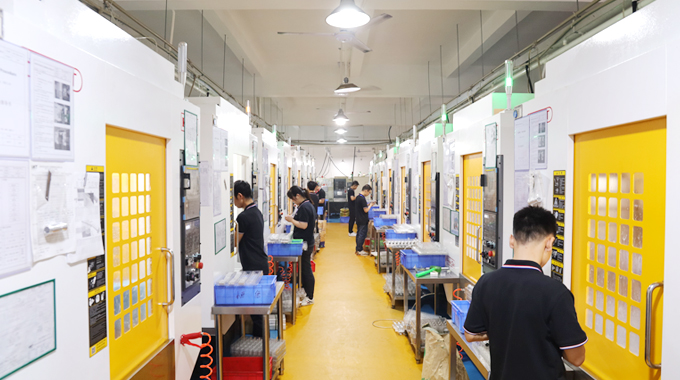
17-4 PH stainless steel is a versatile and high-performance alloy widely used in CNC machining for applications requiring a combination of high strength, excellent corrosion resistance, and good dimensional stability. Its precipitation hardening capability allows it to achieve impressive hardness and mechanical properties, making it suitable for demanding industries such as aerospace, marine, medical, and industrial manufacturing.
While 17-4 PH offers superior strength compared to common stainless steels like 304, it also provides better machinability and hardness, enabling precise, reliable CNC machining parts with tight tolerances. However, it is essential to consider its limitations in extreme corrosion environments and specialized applications requiring ultra-fine edge sharpness.
Choosing 17-4 PH stainless steel is ideal when projects demand a balance of durability, corrosion resistance, and cost-effectiveness. VMT’s expertise in stainless steel CNC machining ensures that parts made from 17-4 PH meet rigorous quality standards, making it a trusted choice for high-performance components.
Q1: Is 17-4 stainless steel magnetic?
Yes, 17-4 PH stainless steel is magnetic in its hardened and annealed conditions due to its martensitic structure.
Q2: Does 17-4 stainless steel rust?
17-4 PH offers excellent corrosion resistance but can rust under severe conditions if not properly maintained or coated.
Q3: How good is 17-4 stainless steel?
It is a high-strength, corrosion-resistant alloy widely valued for aerospace, marine, and industrial applications, offering a great balance of hardness and toughness.
Q4: How much does 17-4 stainless steel cost?
Prices vary by market and quantity but generally, 17-4 PH is more expensive than standard stainless steels like 304 or 316 due to alloying and processing costs.
Q5: What is the tensile strength of 17-4 stainless steel?
Tensile strength ranges from approximately 930 MPa (annealed) to 1,310 MPa (aged/heat treated), depending on heat treatment.
Q6: Is 17-4 PH stainless steel suitable for making welded parts?
Yes, it can be welded, but post-weld heat treatment is recommended to restore mechanical properties and reduce brittleness.
Q7: What is the density of 17-4 PH stainless steel?
The density is about 7.75 to 7.85 g/cm³.
Q8: How does the heat treatment process enhance the strength of 17-4 PH stainless steel?
Heat treatment causes precipitation hardening, where fine particles form in the microstructure, significantly increasing strength and hardness.
Q9: Is 17-4 PH stainless steel suitable for 3D printing?
It is less common but possible with specialized metal additive manufacturing techniques; however, post-processing is needed to achieve full mechanical properties.
Q10: How to drill holes in 17-4 PH stainless steel?
Use sharp, carbide drill bits with slow speeds and steady feed rates, applying cutting fluid to reduce heat and tool wear.
